Communities - Western
Jump to: Madison County Communities | St. Clair County Communities
Bond County
Mulberry Grove
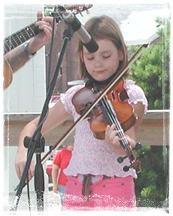 Mulberry Grove was first settled in 1826 by Zopher Foster. The town was originally titled Houston, but was known for many years as Shake Rag because a rag was often shook in the air at the stagecoach stop to signal that there were passengers awaiting pickup. The name Mulberry Grove was selected by Rev. J.B. Woolard, the town's first postmaster, who noted the abundance of the tree.
Mulberry Grove was first settled in 1826 by Zopher Foster. The town was originally titled Houston, but was known for many years as Shake Rag because a rag was often shook in the air at the stagecoach stop to signal that there were passengers awaiting pickup. The name Mulberry Grove was selected by Rev. J.B. Woolard, the town's first postmaster, who noted the abundance of the tree.
Hudson Park, just north of Mulberry Grove, was a popular amusement park from the late 1800's through the 1930's. The park offered a swimming pool, roller skating, dancing, boating, and fishing. The town faced a major setback when a fire in June 1959 destroyed several businesses, including the three-story Masonic building. Mulberry Grove’s most prominent honorary citizen was the famous clown, Emmett Kelly, whose parents lived on a farm near the town. He last visited the community in the 1950's.
Mulberry Grove has a National Road kiosk located on historic Route 40 near the center of the business district.
Smithboro
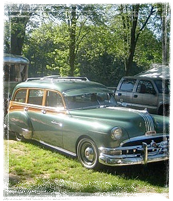 Smithboro (originally Smithborough) was founded in 1870 by Henry H. Smith, a man who could have been the forerunner of Donald Trump. His entrepreneurial skills saw him own a creamery, newspaper, coal mine, hotel, and livestock. Upon purchasing the land that would eventually become a town, he brokered a deal with the Vandalia Railroad, providing them with right-of-way in exchange for building a station on his property. Later, a second railroad was built from north to south that is now known as the Burlington Northern Santa Fe.
Smithboro (originally Smithborough) was founded in 1870 by Henry H. Smith, a man who could have been the forerunner of Donald Trump. His entrepreneurial skills saw him own a creamery, newspaper, coal mine, hotel, and livestock. Upon purchasing the land that would eventually become a town, he brokered a deal with the Vandalia Railroad, providing them with right-of-way in exchange for building a station on his property. Later, a second railroad was built from north to south that is now known as the Burlington Northern Santa Fe.
Smith started his own newspaper in 1883 in hopes of luring the county seat away from Greenville to his village. At its peak, Smithboro had a population of around 600. There were several attempts at coal mining at Smithboro, the earliest dating back to 1884. The last mine closed in 1910.
Greenville
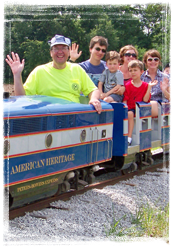 Dating back to 1815, Greenville is one of the oldest towns on the National Road. Known for its deep religious roots, some of its residents were believed to have been involved with the Underground Railroad. In 1855, Almira College, an all girls school, was opened and in 1892 became Greenville College, a four-year school affiliated with the Free Methodist Church. The original Almira College building now houses the Bock Museum, dedicated to the works of sculptor Richard W. Bock. Andrew Carnegie provided $10,000 for the construction of a public library, which opened in 1905 and remains in the same building today.
Dating back to 1815, Greenville is one of the oldest towns on the National Road. Known for its deep religious roots, some of its residents were believed to have been involved with the Underground Railroad. In 1855, Almira College, an all girls school, was opened and in 1892 became Greenville College, a four-year school affiliated with the Free Methodist Church. The original Almira College building now houses the Bock Museum, dedicated to the works of sculptor Richard W. Bock. Andrew Carnegie provided $10,000 for the construction of a public library, which opened in 1905 and remains in the same building today.
In 1858, Lincoln and Douglas spoke here a month apart while campaigning for the U.S. Senate. Other famous visitors have included Teddy Roosevelt, cowboy actor Tom Mix, "Our Gang" star Spanky McFarland, baseball legend Tommy Lasorda, magician David Copperfield and Ronald Reagan, who made the town a 1980 presidential campaign stop. William A. Northcott, a two term Illinois Lieutenant Governor, was a Greenville resident. "Jars of Clay", a very successful Christian band, got its start on the Greenville College campus. Greenville is the birthplace of Job Adams Cooper, Colorado's sixth Governor. The town has a rich industrial heritage including Pet Milk, DeMoulin Bros. (band uniforms), Nevco (scoreboards), and Carlisle Syntech (rubber roofing.) Visitors will enjoy the Bock Museum, Bond County Historical Society Museum, DeMoulin Museum, American Farm Heritage Museum, and the One Room School Museum.
Greenville has a National Road kiosk located opposite the Greenville Public Library
Pocahontas
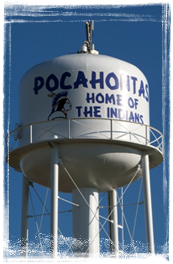 Founded in 1828 as Hickory Grove by Benjamin Johnson who named it for the hickory trees that surrounded his log cabin, the town was a popular stagecoach stop. Johnson was also the first postmaster and owned a blacksmith shop. The Amity Hotel opened in 1837 and some travelers began calling the town Amity. The first school, the Amity Academy, was later sold, moved across the street, and became the National Hotel. The name of the post office was changed in 1850 to Pocahontas. There are conflicting stories on how this name was selected. The school name is the Indians and images of the Indian princess, Pocahontas, can be found many places, including the water tower.
Founded in 1828 as Hickory Grove by Benjamin Johnson who named it for the hickory trees that surrounded his log cabin, the town was a popular stagecoach stop. Johnson was also the first postmaster and owned a blacksmith shop. The Amity Hotel opened in 1837 and some travelers began calling the town Amity. The first school, the Amity Academy, was later sold, moved across the street, and became the National Hotel. The name of the post office was changed in 1850 to Pocahontas. There are conflicting stories on how this name was selected. The school name is the Indians and images of the Indian princess, Pocahontas, can be found many places, including the water tower.
A mine operated sporadically from 1906 through 1942 with 500 employed at its glory. A local bank was the site of a robbery in 1925 by members of the infamous Charlie Birger gang. A total of 12 shots were fired, no one was hurt, and the robbers got away with around $10,000. Nearby Nuby's Steakhouse got its start in the 1920s as the Big Shoal Amusement Park, famous for its swimming pool, gym, merry-go-round, and live entertainment. Country star Gretchen Wilson has embraced Pocahontas as her hometown and featured the song "Pocahontas Proud" on her debut album.
Pocahontas has a National Road kiosk located in the town square.
Madison County
Highland
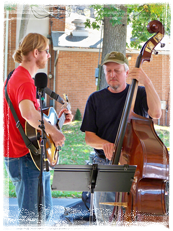 Settled in 1831 by Dr. Kasper Koepfli, his nephew, Joseph Suppiger, and thirteen other immigrants from Sursee, Switzerland, the town was originally known as Helvetia (New Switzerland) before changing in 1836 to Highland. The name change was prompted by Joseph Semple, an Alton man and Illinois House of Representatives member, who told the settlers that the area reminded him of where he grew up in Scotland. Semple was among a group of land investors that platted the town.
Settled in 1831 by Dr. Kasper Koepfli, his nephew, Joseph Suppiger, and thirteen other immigrants from Sursee, Switzerland, the town was originally known as Helvetia (New Switzerland) before changing in 1836 to Highland. The name change was prompted by Joseph Semple, an Alton man and Illinois House of Representatives member, who told the settlers that the area reminded him of where he grew up in Scotland. Semple was among a group of land investors that platted the town.
Highland became a popular draw for immigrants, and by the late 19th century, had one of the largest Swiss populations in the United States. Until the early 1900s, the town newspaper was printed in German. Highland was home to Louis A. Latzer, president of the Helvetia Milk Condensing Company, later known as Pet Milk. Latzer perfected the process of condensing milk and saw the company grow to world acclaim. The Latzer estate, south of Highland, is now a museum that hosts the annual Latzer Homestead Power Days in September. Other early industry included Schott's Brewery and the Wicks Organ Company, which also began manufacturing aircraft parts during the Depression. Kaeser Park, formerly a stagecoach stop, is now a museum, playground, and nature trail. Also of interest is the Erwin Weder Museum which houses vintage farm machinery and vehicles.
St. Jacob
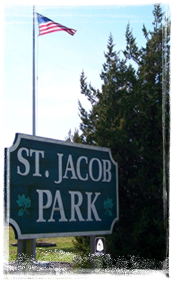 The first settlers arrived around 1810 and built their homes west of present St. Jacob near Silver Creek. Indian hostilities related to the War of 1812 led to the construction of Chilton Fort for protection from possible attacks. This settlement eventually faded into the Illinois prairie. A few years later Jacob Schultz built St. Jacob's first house and sold whiskey by the gallon to travelers. In 1849 Jacob Schroth opened a store and tavern along the National Road, also known as the St. Louis Wagon Road. Schultz, Schroth, and Jacob Willi, the town blacksmith, decided to name the town after themselves, St. Jacobs. Eventually the "s" was dropped although the town is listed as St. Jacobs on old Illinois maps. A post office was established in 1851, and the town was platted in 1866.
The first settlers arrived around 1810 and built their homes west of present St. Jacob near Silver Creek. Indian hostilities related to the War of 1812 led to the construction of Chilton Fort for protection from possible attacks. This settlement eventually faded into the Illinois prairie. A few years later Jacob Schultz built St. Jacob's first house and sold whiskey by the gallon to travelers. In 1849 Jacob Schroth opened a store and tavern along the National Road, also known as the St. Louis Wagon Road. Schultz, Schroth, and Jacob Willi, the town blacksmith, decided to name the town after themselves, St. Jacobs. Eventually the "s" was dropped although the town is listed as St. Jacobs on old Illinois maps. A post office was established in 1851, and the town was platted in 1866.
The Vandalia Railroad reached St. Jacob in 1868 and spurred growth on the north side of the village. Agriculture has played a big part in St. Jacob's history as one of its natives, Louis A. Spies, was president of the Union Dairy Co. of St. Louis and was a leading dairyman in Illinois. In 1906, a group of St. Jacob residents formed the Home Telephone Co. that today serves a 52 square-mile area. The area had an oil rush in the 1940s when 18 wells were sunk in 1942 alone. St. Jacob is well-known for its annual homecoming which began in 1924 and has generated funds for numerous internal improvements.
St. Jacob has a National Road kiosk located in St. Jacob Park.
Troy
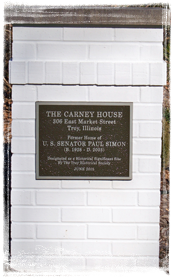 The earliest record of this community was recorded at the federal land office in September 1814 by John Jarvis. Five years later, Jarvis sold ten acres to James Riggin and David Hendershott who gave the town its name. Within a year, the village's population had surpassed 100. A post office opened in 1833 and the town emerged as a stagecoach stop for travelers to and from St. Louis. Agriculture and mining were major contributors to the Troy economy. Paul Simon, a member of the U.S. House and Senate and unsuccessful presidential candidate, in 1948 became the youngest editor and publisher of a newspaper when he took ownership of the Troy Tribune. The Carney House, built in 1871 by John Carney, a local miller, was Simon’s home from 1959 to 1974.
The earliest record of this community was recorded at the federal land office in September 1814 by John Jarvis. Five years later, Jarvis sold ten acres to James Riggin and David Hendershott who gave the town its name. Within a year, the village's population had surpassed 100. A post office opened in 1833 and the town emerged as a stagecoach stop for travelers to and from St. Louis. Agriculture and mining were major contributors to the Troy economy. Paul Simon, a member of the U.S. House and Senate and unsuccessful presidential candidate, in 1948 became the youngest editor and publisher of a newspaper when he took ownership of the Troy Tribune. The Carney House, built in 1871 by John Carney, a local miller, was Simon’s home from 1959 to 1974.
In recent years, Troy has become one of the fastest growing communities on the Illinois side of the St. Louis metropolitan area. According to census numbers, the population has grown from 6,046 in 1990 to 8,524 in 2000. A 2007 special census revealed the city had jumped to 10,083 residents.
The Mersinger cabin, located in the Bud Kaustermeier City Park on South Highway 162, also known as the ”National Road”, is a unique attraction to the park and is available for viewing and educational programs for students and those who are curious about history. The Troy Historical Society takes pride in serving the community as caretakers of this primitive dwelling of our past and welcomes visitors.
Troy has a National Road kiosk located next to the Mersinger cabin
Collinsville
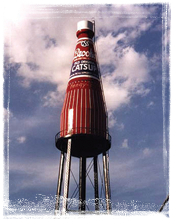 Horseradish, a big catsup bottle, and Italian immigrant heritage are among the things unique to Collinsville. The self-proclaimed "Horseradish Capital of the World, Collinsville also boasts the world's largest catsup bottle, a 170 foot tall water tower in the shape of a catsup bottle. In 1810, John Cook, a settler from Virginia, built the first permanent home but sold out eight years later to the Collins family. Soon there was a grist mill, sawmill, blacksmith and store, and the town was platted in 1837. Originally, the town was called Unionville, but after being told this conflicted with another Illinois town of the same name, Collinsville was selected in honor of its pioneering family. Cahokia Mounds, west of Collinsville, was a 4,000 acre complex with some 120 mounds from around AD 700 to AD 1300. At its peak, this prehistoric Indian city had a population of 20,000.
Horseradish, a big catsup bottle, and Italian immigrant heritage are among the things unique to Collinsville. The self-proclaimed "Horseradish Capital of the World, Collinsville also boasts the world's largest catsup bottle, a 170 foot tall water tower in the shape of a catsup bottle. In 1810, John Cook, a settler from Virginia, built the first permanent home but sold out eight years later to the Collins family. Soon there was a grist mill, sawmill, blacksmith and store, and the town was platted in 1837. Originally, the town was called Unionville, but after being told this conflicted with another Illinois town of the same name, Collinsville was selected in honor of its pioneering family. Cahokia Mounds, west of Collinsville, was a 4,000 acre complex with some 120 mounds from around AD 700 to AD 1300. At its peak, this prehistoric Indian city had a population of 20,000.
In 1870, Collinsville entered its coal mining era and by 1922, 3,000 coal miners lived in Collinsville out of a total population of 9,800. The Miner's Institute Building, built in 1918 by the local coal mining unions as a labor hall, has served as an entertainment center for generations. The theater has hosted vaudeville troupes, live bands, high school graduations, movie showings, and in recent years, theatrical productions. Because the Collinsville area is a rich producer of horseradish, it is known as the "Horseradish Capital of the World". The G.S. Suppiger Co., makers of Brooks Catsup, erected a 77-foot tall water tower in the shape of a catsup bottle. Although the factory closed in the 1960s, the water tower remains as a popular tourist draw. The city honors its Italian heritage with an Italian Fest every September. Famous Collinsville residents have included Chicago Bears legend George Musso, St. Louis Cardinals outfield Terry Moore, and Michael Stipe of the rock band R.E.M.
The newly developed Collins Park in Collinsville features the historic Daniel Dove Collins House which was built in 1845 in the Greek Revival style. Irving Dilliard bought the home at auction ten years earlier and donated it the city of Collinsville. Two commercial buildings were demolished to make way for the square block public park. The historic preservation commission raised funds to restore the home. No public funds were used in its restoration. Friends of the D.D. Collins House are charged with raising funds for marketing plans, developing educational programs, staffing the site, and opening it for tours and school field trips. A new Collinsville sign will be erected on the site to showcase the downtown section of the city.
Collinsville has a National Road kiosk located on Main Street in Collins Park behind the Collins House.
Cahokia Mounds
Cahokia Mounds is the largest pre-historic site north of Mexico. At its height, the city, arranged around open plazas, had approximately 20,000 residents. A total of 120 mounds were built. See first-hand where Mississippi Indians were living 1,000 years ago, building mounds and an astronomical calendar of 48 cedar posts arranged in a 410-foot circle with a post in the center. From this center post they marked the equinoxes and summer and winter solstices. Forty posts of this antique Woodhenge have been replaced in their original positions. Nearby are Monk's Mound (largest earthworks of the ancient world) and an excellent interpretive center. It is located near Collinsville, Illinois.
Cahokia Mounds has a National Road kiosk located near the Interpretive Center.
St. Clair County
Fairmont City
 Historical information on Fairmont City is being gathered. Please check back for information on this community that is part of the great National Road.
Historical information on Fairmont City is being gathered. Please check back for information on this community that is part of the great National Road.
East St. Louis
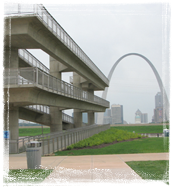 East St. Louis was originally part of the prehistoric Mississippian culture mound complex. The French were the first Europeans to live in the area around 1700, but it wasn't until the 1780s that it was inhabited by American settlers. Illinoistown, the forerunner of East St. Louis, was founded in 1818. By the mid-19th century, the town had become a major industrial and trade center. Agriculture, coal mining, the railroad, and river commerce contributed to its success. The city's name was changed in 1861 to East St. Louis. The 1874 opening of the Eads Bridge allowed rail traffic to cross the Mississippi River at East St. Louis. Designed by James B. Eads, it was the world's longest arch bridge at the time of completion.
East St. Louis was originally part of the prehistoric Mississippian culture mound complex. The French were the first Europeans to live in the area around 1700, but it wasn't until the 1780s that it was inhabited by American settlers. Illinoistown, the forerunner of East St. Louis, was founded in 1818. By the mid-19th century, the town had become a major industrial and trade center. Agriculture, coal mining, the railroad, and river commerce contributed to its success. The city's name was changed in 1861 to East St. Louis. The 1874 opening of the Eads Bridge allowed rail traffic to cross the Mississippi River at East St. Louis. Designed by James B. Eads, it was the world's longest arch bridge at the time of completion.
 The National Stockyards, opened in 1871, would become its number one industry. Created by a group of railroad men, meat packers, and livestock operators, the stockyards complex, including the National Hotel and Exchange Building, cost one and a half million dollars. Three major meat processors, Swift, Armour, and Hunter, operated in the East St. Louis region incorporated as National City. Each employed thousands of workers, leading to the city's nickname "Hog Capital of the Nation". Tensions among laborers led to a race riot in 1917 in which 100 or more blacks were killed, neighborhoods were burned, and thousands were left homeless.
The National Stockyards, opened in 1871, would become its number one industry. Created by a group of railroad men, meat packers, and livestock operators, the stockyards complex, including the National Hotel and Exchange Building, cost one and a half million dollars. Three major meat processors, Swift, Armour, and Hunter, operated in the East St. Louis region incorporated as National City. Each employed thousands of workers, leading to the city's nickname "Hog Capital of the Nation". Tensions among laborers led to a race riot in 1917 in which 100 or more blacks were killed, neighborhoods were burned, and thousands were left homeless.
East St. Louis' population hits its peak of 82,000 in the 1950s, but, as the decade turned, so did the city's prosperity. From 1960 to 1980, 13,000 industrial jobs were lost as companies pulled up stakes and moved out of East St. Louis. The city has earned a reputation as a melding pot of blues, rock and roll, and jazz music. Entertainers with an East St. Louis connection include Josephine Baker, Miles Davis, Katherine Dunham, and Ike and Tina Turner. The city was the birthplace of numerous athletes, including tennis star Jimmy Connors, track legends Jackie Joyner-Kersee and Al Joyner, football Hall of Famer Kellen Winslow, and New York Yankees legend Hank Bauer. Today, the Casino Queen riverboat is a popular draw to the East St. Louis riverfront.



